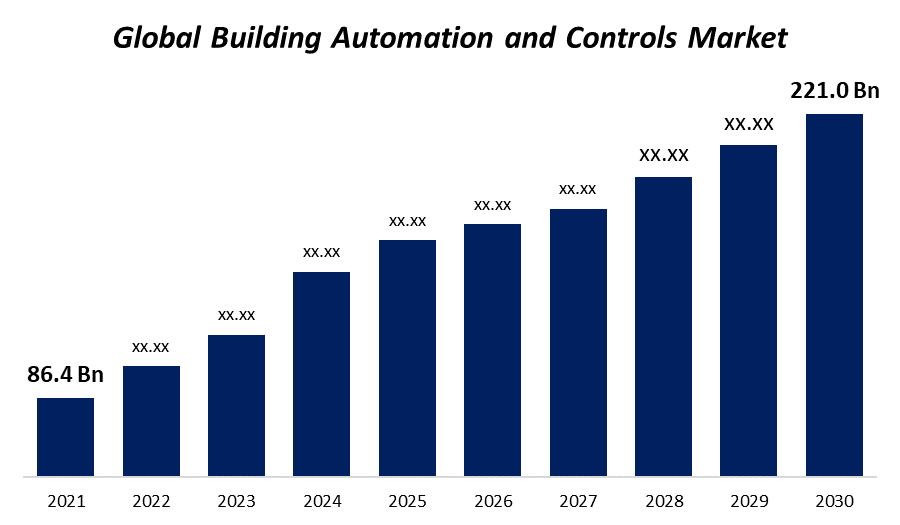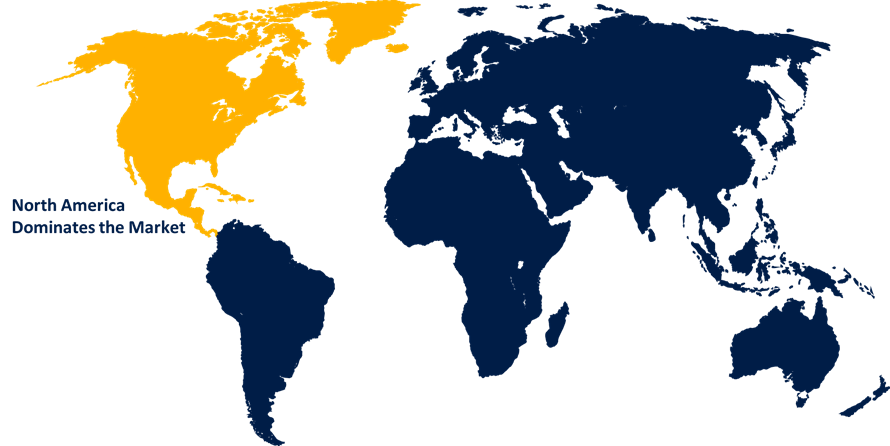Global Building Automation and Controls Market Size, Share, and COVID-19 Impact Analysis By Product (HVAC Control, Lighting Control, and Security & Access Control), By Offering (Integration and Services), By Industry Vertical (Residential, Industrial, Hospitality, Enterprise, Retail, and Others), and By Region (North America, Europe, Asia-Pacific, Latin America, Middle East, and Africa), Analysis and Forecast 2021 - 2030.
Industry: Construction & ManufacturingGlobal Building Automation and Controls Market Insights Forecasts to 2030
- The global building automation and controls market was valued at USD 86.4 billion in 2021.
- The market is growing at a CAGR of 11% from 2021 to 2030
- The global building automation and controls market is expected to reach USD 221.0 billion by 2030
- The Asia- Pacific is expected to grow the fastest during the forecast period

Get more details on this report -
The global building automation and controls market is expected to reach USD 221.0 billion by 2030, at a CAGR of 11% during the forecast period 2021 to 2030. Building automation makes it easy to control and keep an eye on how the systems in the building work. These include facility management systems, security and access controls, fire and life safety alarms, and other safety alarms. Building automation helps reduce the amount of energy used in buildings, makes them more comfortable for the people who live there, and makes it easier to run the building's activities. One of the main things that are making the market for building automation systems grow is the growing need for buildings that use less energy and have better security systems.
Market Overview:
The term "building automation and controls" refers to the automatic and centralized control of building systems like lighting, security, access management, and heating, ventilation, and air conditioning (HVAC) systems. For the building automation and control system to work right, it needs to be connected to a central computer system. This access is made possible by the system's sensors, detectors, relays, and other smart electronics. It is expected that the growing use of building automation systems in important office buildings, shopping centers, and public transportation hubs like airports and train stations will help the market for building automation and control systems grow. Controls for lighting, heating, ventilation, air conditioning (HVAC), and air conditioning, as well as security and access control systems, are some of the most common products used in homes and businesses. As a result, it is expected that the global market for building automation systems will grow because there will be a greater need to manage HVAC systems, control lighting that uses less energy, and improve the quality of life.
Report Coverage
This research report categorizes the market for global building automation and controls market-based on various segments and regions, forecasts revenue growth, and analyzes trends in each submarket. The report analyses the key growth drivers, opportunities, and challenges influencing the global building automation and controls market. Recent market developments and competitive strategies such as expansion, product launch and development, partnership, merger, and acquisition have been included to draw the competitive landscape in the market. The report strategically identifies and profiles the key market players, analyses their core competencies in each global building automation, and controls market sub-segments.
Global Building Automation and Controls Market Report Coverage
| Report Coverage | Details |
|---|---|
| Base Year: | 2021 |
| Market Size in 2021: | USD 86.4 billion |
| Forecast Period: | 2021-2030 |
| Forecast Period CAGR 2021-2030 : | 11% |
| 2030 Value Projection: | USD 221.0 billion |
| Historical Data for: | 2017-2020 |
| No. of Pages: | 195 |
| Tables, Charts & Figures: | 135 |
| Segments covered: | By Product, By Offering, By Industry Vertical, By Region, COVID-19 Impact Analysis |
| Companies covered:: | Honeywell International, Siemens AG, Beijer Electronics, ABB, Johnson Controls, Schneider Electric, General Electric, Legrand, Lutron Electronics Co., Control4 Corporation |
| Pitfalls & Challenges: | COVID-19 has the potential to impact the global market |
Get more details on this report -
Segmentation Analysis
- In 2021, the HVAC control segment dominated the market with the largest market share of 39% and market revenue of 33.6 billion.
Based on Material type, the building automation and controls market is categorized into HVAC Control, Lighting Control, and Security & Access Control. In 2021, the HVAC control segment dominated the market with the largest market share of 39% and market revenue of 33.6 billion. There is no longer a need for wired controls for the control system. Instead, smart devices such as smartphones and tablets can be controlled from afar. Better sensors are now being added to the controls for the HVAC system. Also, there are better options for systems controlled by themselves and based on how many people are in the building and what the space is used for. So, improvements in HVAC systems are one of the main things driving growth in the building automation and controls market.
- In 2021, the integration segment accounted for the largest share of the market, with 57% and market revenue of 49.2 billion.
Based on offerings, the building automation and controls market is categorized into Integration and Services. In 2021, integration dominated the market with the largest market share of 57% and market revenue of 49.2 billion. The market for integrating building automation and control systems is driven by several things, such as the rise in demand for energy-efficient control systems and the increase in infrastructure building. Future market growth is also expected to be helped by more research and development on AI and the Internet of Things. In recent years, the market for heating, ventilation, and air conditioning (HVAC) systems with inverters has grown significantly, which has caused a big change in the situation. The available solutions can no longer be used as an integration choice.
- In 2021, the industrial segment accounted for the largest share of the market, with 25% and market revenue of 21.6 billion.
Based on industry vertical, the building automation and controls market is categorized into Residential, Industrial, Hospitality, Enterprise, Retail, and Others. In 2021, industrial dominated the market with the largest market share of 25% and market revenue of 21.6 billion. Building automation and the improvement of HVAC technology work together to make it easier to manage energy production, distribution, air conditioning, and heat recovery. All these things help cut costs and save resources while making energy use more efficient. It is expected that sensors that can share information at low rates while maintaining a high efficiency level will be the main reason for the growth of smart buildings in the industrial sector. The data is also put together at a high level in the management of the building automation system. Because the building can now run more efficiently and cost-effectively, the market for building automation and controls has more room to grow.
Regional Segment Analysis of the Building Automation and Controls Market

Get more details on this report -
- North America (U.S., Canada, Mexico)
- Europe (Germany, France, the U.K., Italy, Spain, Rest of Europe)
- Asia-Pacific (China, Japan, India, Rest of APAC)
- South America (Brazil and the Rest of South America)
- The Middle East and Africa (UAE, South Africa, Rest of MEA)
Among all regions, North America emerged as the largest market for the global building automation and controls market, with a market share of around 35.56% and 86.4 billion of the market revenue in 2021.
- In 2021, North America emerged as the largest market for the global building automation and controls market, with a market share of around 35.56% and 86.4 billion of the market revenue. This is because of the growth of automated security systems, the fast spread of internet of things technology, and wireless sensor network building automation and controls technology. Building automation system installations are growing faster in North America. This is because the smart cities project is growing quickly, and there is more demand for new technology. Leading countries like the United States and Canada are getting more involved in the market for building automation and controls. This is on top of getting official approvals. Leading companies in the field of building automation systems, like Siemens, are becoming more well-known, which is another reason why the market for building automation and controls is growing. These companies have been cutting the edge of technological progress and big new ideas.
- The Asia- Pacific market is expected to grow at the fastest CAGR between 2022 and 2030. This rise may have something to do with the high economic growth of major countries in the Asia-Pacific region and the growth predictions for the construction industry. The building automation and controls market in APAC is expected to grow because the region is becoming more urbanized quickly, and more people are willing to use smart city technologies. Several businesses are also buying embedded building automation and controls and the buildings they run, which is another driving up market demand. In the Asia-Pacific region, demand for building automation and control systems is also increasing because of more advanced security systems, the widespread use of Internet of Things technology, and the rise in wireless technology use.
Competitive Analysis:
The report offers an appropriate analysis of the key organizations/companies involved in global building automation. It controls the market along with a comparative evaluation primarily based on its product offering, business overviews, geographic presence, enterprise strategies, segment market share, and SWOT analysis. The report also provides an elaborative analysis focusing on the companies' current news and developments, including product development, innovations, joint ventures, partnerships, mergers & acquisitions, strategic alliances, and others. This allows for the evaluation of the overall competition within the market.
List of Key Market Players:
- Honeywell International
- Siemens AG
- Beijer Electronics
- ABB
- Johnson Controls
- Schneider Electric
- General Electric
- Legrand
- Lutron Electronics Co.
- Control4 Corporation
Key Target Audience
- Market Players
- Investors
- End-users
- Government Authorities
- Consulting And Research Firm
- Venture capitalists
- Third-party knowledge providers
- Value-Added Resellers (VARs)
Recent Development
- June 2022, NVIDIA and Siemens AG have expanded their partnership to enable the industrial metaverse and increase the use of AI-driven digital twin technology, which will help take industrial automation to a new level.
- In June 2022, Siemens AG announced that Siemens Xcelerator, an open digital business platform, would be released. Siemens Xcelerator was made to speed up digital transformation and value creation for clients of all sizes in various industries, such as buildings, grids, and mobility. The business platform makes it possible to do the digital transformation quickly and in a way that can be scaled up.
Market Segment
This study forecasts global, regional, and country revenue from 2019 to 2030. Spherical Insights has segmented the global building automation and controls market-based on the below-mentioned segments:
Global Building Automation and Controls Market, By Product
- HVAC Control
- Lighting Control
- Security & Access Control
Global Building Automation and Controls Market, By Offering
- Integration
- Services
Global Building Automation and Controls Market, By Industry Vertical
- Residential
- Industrial
- Hospitality
- Enterprise
- Retail
- Others
Global Building Automation and Controls Market, Regional Analysis
- North America
- The US
- Canada
- Mexico
- Europe
- Germany
- Uk
- France
- Italy
- Spain
- Russia
- Rest of Europe
- The Asia Pacific
- China
- Japan
- India
- South Korea
- Australia
- Rest of Asia Pacific
- South America
- Brazil
- Argentina
- Rest of South America
- Middle East & Africa
- UAE
- Saudi Arabia
- Qatar
- South Africa
- Rest of the Middle East & Africa
Need help to buy this report?